Victorian majolica


Victorian majolica properly refers to two types of majolica made in the second half of the 19th century in Europe and America.[1]
Firstly, and best known, there is the mass-produced majolica decorated with coloured lead glazes, made in Britain, Europe and the US; typically hard-wearing, surfaces moulded in relief, vibrant translucent glazes, in occasionally classical but mostly naturalistic styles, often with an element of High Victorian whimsy.
Secondly, there is the much less common tin-glazed majolica made primarily by Mintons from 1848 to circa 1880, typically with flat surfaces, opaque white glaze with fine brush painted decoration in imitation of the Italian Renaissance maiolica process and styles.
Glazes
Glaze is a vitreous coating on a ceramic. Types of glazing include feldspathic or alkali-glazed, salt-glazed, lead-glazed, and tin-glazed.
Lead oxide is a key ingredient of both lead and tin glazes. Lead oxide is a flux that causes lead and tin glazes to fuse to the earthenware biscuit body at a low oven temperature, about 800 °C. The other ingredients in lead and tin glazes are typically an equally large quantity of silicates, and a small proportion of alkali (feldspar or similar) ground up with a little water and the large proportion of lead oxide to form a paste.
A coloured glaze results from adding a small amount of particular metal oxides to plain lead glaze, different metal oxides producing different colours.[2] Since mid-19th century coloured glazes earthenware has been known as majolica.[3]
An opaque white tin-glaze results from adding a small amount of tin oxide to plain lead glaze. Decorated with brush-painted enamels, tin-glazed earthenware from mid-15th century onwards has been known as maiolica,[4] also later as faience, delftware, talavera, or rarely majolica, though commonly majolica in the US.[5]
Coloured glazes
majolica n. 1. is earthenware decorated with coloured lead glazes applied directly to an unglazed body. Victorian majolica is the familiar mass-produced earthenware decorated with coloured lead glazes[6] made during the Victorian era (1837–1900) in Britain, Europe and the US, typically hard-wearing, surfaces frequently moulded in relief, vibrant translucent glazes, in a variety of styles and forms[7] (some examples below). Shown in Britain at the Exhibitions of 1851 and 1862,[8] it became fashionable, widely copied and mass-produced world-wide. Also known as: maiolica, Palissy ware, coloured glazes majolica, coloured-glazed majolica, lead-glazed majolica, and misleadingly 'lead or tin glazed' majolica.
Some coloured glazes majolica was produced in traditional Classical or Revivalist[9] styles, but Darwinism, natural history, their English country gardens, expeditions abroad, and trade in oriental products generated more exciting styles appealing to the upcoming merchant classes. There was a boom in naturalistic[10] pottery, often with an element of whimsy, to which Minton's inexpensive, durable, multi-purpose product was well suited. A strong interest in the world at large generated passing fashions for Egyptian forms, Japanese styles, Chinoiserie and High Victorian style. Conservatories became a fashion statement. Adorning them were spectacular majolica garden seats, flower pots, jardinières, stands, large birds and animals. The irrepressible urge to impress guests with rare food led to the growing of pineapples and egg-plants (aubergines) formerly only available overseas. These too appeared as decorative objects for admiration around the home. Minton's Palissy ware boomed. Pottery makers throughout Britain, Europe and the US copied the process with great success, albeit variable quality. Palissy ware/Majolica went global.
-
 Candelabra, 16.9 in, coloured glazes majolica, 1864, Revivalist in style
Candelabra, 16.9 in, coloured glazes majolica, 1864, Revivalist in style -
 Bread plate or corn platter, temperature compatible coloured glazes on biscuit, naturalistic in style, surfaces molded in relief
Bread plate or corn platter, temperature compatible coloured glazes on biscuit, naturalistic in style, surfaces molded in relief -
 Tobacco Jar and cover, coloured glazes majolica, 1868, naturalistic in style
Tobacco Jar and cover, coloured glazes majolica, 1868, naturalistic in style -
 Goblet, 9.2 in, coloured glazes, c. 1869, Revivalist in style
Goblet, 9.2 in, coloured glazes, c. 1869, Revivalist in style -
 Jug, coloured glazes majolica, c. 1870, naturalistic in style, Scotland
Jug, coloured glazes majolica, c. 1870, naturalistic in style, Scotland -
 Asparagus server (table ware), 13.4 in, c. 1870, naturalistic coloured glazes majolica
Asparagus server (table ware), 13.4 in, c. 1870, naturalistic coloured glazes majolica -
 Strawberry jar and cover, coloured glazes, c. 1870, naturalistic style
Strawberry jar and cover, coloured glazes, c. 1870, naturalistic style -
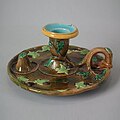 Candle holder, coloured and mottled glazes, c. 1870, naturalistic style
Candle holder, coloured and mottled glazes, c. 1870, naturalistic style -
 Dessert plate, coloured glazes, c. 1870, naturalistic style
Dessert plate, coloured glazes, c. 1870, naturalistic style -
 Tobacco jar and cover, c. 1870, coloured glazes, Portugal
Tobacco jar and cover, c. 1870, coloured glazes, Portugal -
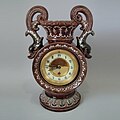 Clock, coloured glazes majolica, c. 1870, Revivalist in style
Clock, coloured glazes majolica, c. 1870, Revivalist in style -
 Vase, plain and colored lead glazes on buff biscuit, mixture of Revivalist styles
Vase, plain and colored lead glazes on buff biscuit, mixture of Revivalist styles -
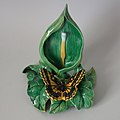 Watch stand for ladies dressing table set, coloured glazes, c. 1874, naturalistic style
Watch stand for ladies dressing table set, coloured glazes, c. 1874, naturalistic style -
 Basket, coloured glazes majolica, 10.2 in, c. 1875, naturalistic in style
Basket, coloured glazes majolica, 10.2 in, c. 1875, naturalistic in style -
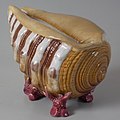 Spoon Warmer, coloured glazes majolica, 1876, ultra naturalistic in style
Spoon Warmer, coloured glazes majolica, 1876, ultra naturalistic in style - Jardinière (flower pot), coloured lead glazes, Revivalist style(s)
-
 Wall plate, c. 1890, coloured lead glazes Palissy majolica, Barbizet, France, ultra-naturalistic in style
Wall plate, c. 1890, coloured lead glazes Palissy majolica, Barbizet, France, ultra-naturalistic in style -
 Toothpick holder, 5.5 in, coloured glazes, Palissy style, Portugal
Toothpick holder, 5.5 in, coloured glazes, Palissy style, Portugal -
 Flower pot, coloured lead glazes on biscuit, naturalistic in style
Flower pot, coloured lead glazes on biscuit, naturalistic in style -
 Teapot, c. 1875, coloured lead glazes on biscuit, Japanese style with an element of whimsy
Teapot, c. 1875, coloured lead glazes on biscuit, Japanese style with an element of whimsy -
 Wall Pockets, coloured glazes majolica, c. 1900, Sarreguemines, France
Wall Pockets, coloured glazes majolica, c. 1900, Sarreguemines, France
Tin-glaze
majolica n. 2. is earthenware, coated with opaque white tin-glaze and ornamented with metallic oxide colours. Tin-glazed Victorian majolica is the rare tin-glazed earthenware made primarily by Mintons[11] from 1848 to circa 1880, typically with flat surfaces, and opaque whitish glaze with brush painted decoration in the style(s) of Italian Renaissance maiolica tin-glazed pottery. Also known as: maiolica; and 'lead or tin' glazed majolica.
Minton's tin-glazed majolica in imitation of Italian maiolica, praised at Exhibitions and purchased by Royalty and museums, made little commercial impact. Other pottery makers shunned the process.
Interest in Renaissance styles was waning, fashion moving on with the usual protestations from older generations: "...the current of fashion, however contrary to right, wisdom, and good taste..."[12]
Cost of production was high. Compared to the lead-glaze process whereby thick, temperature-compatible coloured lead glazes were applied direct to the biscuit, simultaneously, then fired, (paint, fire), the tin-glaze process required extra stages for dipping/coating and drying the tin-glaze before decoration could even begin, (dip, dry, paint, fire). Added to this, the expense of brushwork decoration, especially the fine painting of pictures and designs, was very time-consuming, requiring highly skilled,[13] higher paid artists.
-
 Minton tin-glazed Majolica plate, imitating tin-glazed Italian Renaissance maiolica process and style.
Minton tin-glazed Majolica plate, imitating tin-glazed Italian Renaissance maiolica process and style. -
 Minton tin-glazed Majolica bowl, 10.4ins, design an exact copy of Renaissance 9.4ins original in V&A, flat surfaces, white glaze, brush painted.
Minton tin-glazed Majolica bowl, 10.4ins, design an exact copy of Renaissance 9.4ins original in V&A, flat surfaces, white glaze, brush painted. -
![Minton tin-glazed Majolica oval plate, painting by Kirkby,[14] after Triumphs of Caesar (Mantegna). Almost identical example in V&A.](//upload.wikimedia.org/wikipedia/commons/thumb/8/8e/Minton_tin-glaze_Majolica_oval_plate_decorated_by_Thomas_Kirkby_in_Renaissance_style_after_Mantegna_original.jpg/98px-Minton_tin-glaze_Majolica_oval_plate_decorated_by_Thomas_Kirkby_in_Renaissance_style_after_Mantegna_original.jpg) Minton tin-glazed Majolica oval plate, painting by Kirkby,[14] after Triumphs of Caesar (Mantegna). Almost identical example in V&A.
Minton tin-glazed Majolica oval plate, painting by Kirkby,[14] after Triumphs of Caesar (Mantegna). Almost identical example in V&A. -
 Minton tin-glazed Majolica tondino, istoriato style depicting 'Jesus among the Scribes', signed E Lessore.
Minton tin-glazed Majolica tondino, istoriato style depicting 'Jesus among the Scribes', signed E Lessore. -
 Minton tin-glazed Majolica vase, 'grotesque' Renaissance style, 'MINTON' to the neck, mostly flat surfaces, opaque white glaze, brush painted.
Minton tin-glazed Majolica vase, 'grotesque' Renaissance style, 'MINTON' to the neck, mostly flat surfaces, opaque white glaze, brush painted. -
 Minton tin-glazed majolica, impressed date cypher 1864, brush-painted with enamels.
Minton tin-glazed majolica, impressed date cypher 1864, brush-painted with enamels. -
 Tin-glazed Minton majolica, base. Note coated not dipped, date cypher 1864, signature brush-painted in manganese oxide.
Tin-glazed Minton majolica, base. Note coated not dipped, date cypher 1864, signature brush-painted in manganese oxide.
Meanings of majolica
The term majolica has been dogged by confusion starting with the English anglicisation of the word maiolica into majolica following the appearance of the letter j in the English alphabet mid-17th century.[15]
Leon Arnoux, the artistic and technical director of Mintons, wrote in 1852 "We understand by majolica a pottery formed of a calcareous clay gently fired, and covered with an opaque enamel composed of sand, lead, and tin..." He was describing the Minton & Co. tin-glazed product made in imitation of Italian maiolica both in process and in styles. Remember, tin-glaze is simply plain lead glaze with a little tin oxide added. His description is often referenced,[16] in error, as a definition of Minton's other new product, the much copied and later mass-produced ceramic sensation of the Victorian era, Minton's coloured lead glazes 'Palissy ware'. The 16th-century French pottery of Bernard Palissy was well known and much admired.[17][18] Mintons adopted the name 'Palissy ware' for their new coloured glazes product, but this soon became known also as majolica.[19] Minton & Co. appear to have done little to promote the clear distinction between their tin-glazed and coloured glazes products.
Minton archive first design for majolica
Thomas Kirkby's design G144 in the Minton Archive[20] is inscribed "This is the First Design for Majolica ...". The design is Italian Renaissance in style. Close-up images illustrate a design suited for fine brushwork on flat surfaces. The design is for Minton's rare tin-glaze Majolica imitation of Italian tin-glaze maiolica. Minton's designs for Palissy ware, also known as majolica, were suited for 'thick' painting of coloured lead glazes onto surfaces moulded in relief to make best use of the intaglio effect.[21]
English makers
Minton, the originator
Great Exhibition (1851)
Victorian majolica was originated by Minton & Co., first exhibited at the Great Exhibition of 1851.
-
 1851 Great Exhibition London, Catalogue Cover
1851 Great Exhibition London, Catalogue Cover -
 1851 Exhibition Catalogue, Minton Exhibit Numbers 60 to 74. Majolica refers to Renaissance Italian maiolica.
1851 Exhibition Catalogue, Minton Exhibit Numbers 60 to 74. Majolica refers to Renaissance Italian maiolica. -
 Lithograph illustrating flower pots, and stands (underplates) and garden seats, see Exhibit Number 60.
Lithograph illustrating flower pots, and stands (underplates) and garden seats, see Exhibit Number 60. -
 Minton Palissy ware/majolica flower vase, coloured glazes, shape first shown at the 1851 Exhibition, Exhibit Number 60
Minton Palissy ware/majolica flower vase, coloured glazes, shape first shown at the 1851 Exhibition, Exhibit Number 60 -
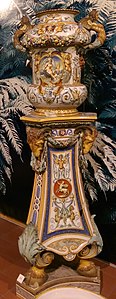 Minton tin-glazed Majolica flower pot and stand (pedestal) in Italian Renaissance maiolica Grotesque style, see Exhibit Number 74
Minton tin-glazed Majolica flower pot and stand (pedestal) in Italian Renaissance maiolica Grotesque style, see Exhibit Number 74
The 1851 Exhibition Catalogue[22] lists the two Victorian majolica products by Minton in consecutive sections.
Earthenware [...] Flowerpots, etc. Exhibit Number 60. "A variety of [...] flowerpots and stands, and garden seats." refers to the coloured glazes product that Mintons called Palissy ware.[23]
Tiles, Terra Cotta, and Vases, etc, in imitation of Majolica Ware. Exhibit Number 74. "Variety of flowerpots and stands, coloured in the majolica style, etc." refers to the tin-glazed product painted with enamels that Mintons called Majolica.
Exposition Universelle (1855)
The Illustrated London News reported with approval on Minton's two new products shown at the Exposition Universelle in Paris:
The collection of Palissy and Majolica ware, however, is that which appears to have created the greatest sensation among Parisian connoisseurs. The reader will remember that the main difference in these wares is that whereas the Palissy ware is coloured by a transparent glaze, Majolica ware contains the colour (opaque) in the material.[24] The care and taste with which these manufactures have been brought by the Messrs. Minton to their present state of perfection, have been amply rewarded. Within a few days of the opening of the Exhibition all the specimens exhibited had been sold.[25]
Despite this reminder Minton's Palissy Ware became known as 'majolica ware'; 'Palissy ware' dropped out of use and 'majolica' stuck. In the 1870s, the curators of the South Kensington Museum (now the V&A) tried to clear up the confusion by reviving the Italian spelling 'maiolica' with an 'i' instead of a 'j' for Italian tin-glaze.[26]
Great Exhibition (1862)
At the second Great Exhibition of the Art-Works of All Nations a range of Minton's products were exhibited and illustrated in the Exhibition Catalogue. Amongst them were the two Minton majolicas a) tin-glazed Minton Majolica and b) coloured glazes Minton Palissy ware soon known also as 'majolica'.
-
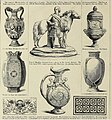 1862 Exhibition Minton exhibits, top left "The Italian vase is Majolica, decorated from a design by Mr. ALFRED STEVENS.", bottom middle "The EWER is a Palissy Vase."
1862 Exhibition Minton exhibits, top left "The Italian vase is Majolica, decorated from a design by Mr. ALFRED STEVENS.", bottom middle "The EWER is a Palissy Vase." -
 Minton Majolica vase, 1862 Exhibition, process and style in imitation of Italian Renaissance maiolica. Victoria and Albert Museum, London
Minton Majolica vase, 1862 Exhibition, process and style in imitation of Italian Renaissance maiolica. Victoria and Albert Museum, London -
 Minton Palissy ware ewer, 1862 Exhibition, process coloured glazes majolica, style Renaissance with a touch of naturalistic
Minton Palissy ware ewer, 1862 Exhibition, process coloured glazes majolica, style Renaissance with a touch of naturalistic
-
 Inkstand, 1860, coloured glazes, naturalistic style
Inkstand, 1860, coloured glazes, naturalistic style -
 Ice stand table centre, 1860, coloured glazes, Revivalist style
Ice stand table centre, 1860, coloured glazes, Revivalist style -
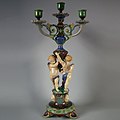 Minton Candelabra, 1860, coloured, mottled, and plain glazes, Revivalist style
Minton Candelabra, 1860, coloured, mottled, and plain glazes, Revivalist style -
 Chestnut server, 1865, 11 in, coloured glazes, naturalistic in style
Chestnut server, 1865, 11 in, coloured glazes, naturalistic in style -
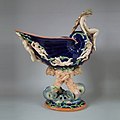 Nautilus shell centrepiece, 1865, coloured glazes, Revivalist style
Nautilus shell centrepiece, 1865, coloured glazes, Revivalist style -
 Garden Seat, 18.1 in, coloured glazes, Chinoiserie in style, 1866
Garden Seat, 18.1 in, coloured glazes, Chinoiserie in style, 1866 -
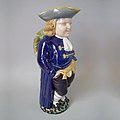 'Quaker man' toby jug, 1867
'Quaker man' toby jug, 1867 -
 Gun dog Game Pie Dish, 17.3 in, coloured and mottled glazes, naturalistic in style
Gun dog Game Pie Dish, 17.3 in, coloured and mottled glazes, naturalistic in style -
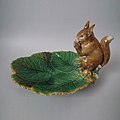 Nut dish, 1869, naturalistic style
Nut dish, 1869, naturalistic style -
 Vases, 1869, rare combination of fine-painted tin-glaze and coloured glazes handles, rim and interior
Vases, 1869, rare combination of fine-painted tin-glaze and coloured glazes handles, rim and interior -
 Garden Seat, 1870, 20 in, coloured glazes, Revivalist motifs
Garden Seat, 1870, 20 in, coloured glazes, Revivalist motifs -
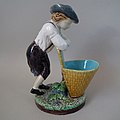 Vintager figural, 1870
Vintager figural, 1870 -
 Tiles, c. 1870, coloured glazes, naturalistic in style
Tiles, c. 1870, coloured glazes, naturalistic in style -
 Candle Holder, 1870, coloured glazes, naturalistic in style
Candle Holder, 1870, coloured glazes, naturalistic in style -
 Tureen, 1870, coloured glazes, naturalistic style
Tureen, 1870, coloured glazes, naturalistic style -
 Oyster server, 1870, coloured glazes, Naturalistic style
Oyster server, 1870, coloured glazes, Naturalistic style -
 Teapot, coconut, mushroom lid, 1872, coloured glazes, naturalistic style with hint of whimsy
Teapot, coconut, mushroom lid, 1872, coloured glazes, naturalistic style with hint of whimsy -
 Cat and mouse jug, 1875, naturalistic style
Cat and mouse jug, 1875, naturalistic style -
 Eggplant-Aubergine vase, 1875, naturalistic style
Eggplant-Aubergine vase, 1875, naturalistic style -
 Pomegranate Vase, 1878, 22 in, coloured glazes, boldly decorative, naturalistic and humorous in style
Pomegranate Vase, 1878, 22 in, coloured glazes, boldly decorative, naturalistic and humorous in style -
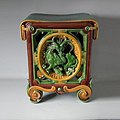 Garden seat, 1880, coloured glazes, in imitation of Tang dynasty sancai
Garden seat, 1880, coloured glazes, in imitation of Tang dynasty sancai
Wedgwood
Wedgwood[27] began to manufacture majolica about ten years after Mintons. Wedgwood's glazes and modelling were denser and more formal than Minton's, but there were many pieces that displayed the naturalism and humour of Minton shapes. Wedgwood's majolica included cachepots, jugs, candlesticks, cheese bells, umbrella stands, sardine boxes, plates in naturalistic patterns, bread trays, etc. In Wedgwood's "greenware" the green glaze emphasizes the low relief patterning, typically of basketwork and foliage. Numerous smaller factories in the Staffordshire Potteries specialised in such green majolica wares in which the translucent glaze brought out the low relief of the cast body: some, like Wedgwood, marked their majolica with impressed stamps.
Majolica was influenced by the design of the old "Cauliflower" and "Pineapple" teapots that had been made by Thomas Whieldon, Wedgwood and other 18th-century Staffordshire potters. Both English and American majolica potters reproduced the "Cauliflower" pattern and other raised fruit, vegetable, leaf, and berry patterns, with green, yellow, pink, brown, light blue and purple-blue glazes. There is also a teapot of yellow corn and green leaves, similar to the old Whieldon "Pineapple" teapots, and a teapot, jug and sugar bowl of pink coral and green seaweed with accents of brown and blue, marked "Etruscan Majolica". Many late 19th-century majolica designs had rustic motifs with backgrounds of basketry and wooden-bound buckets decorated with moulded flowers, birds, fish and animals. Handles were made to resemble tree branches, rose stems and twined flowers and leaves.
Plates, jugs, teapots and other articles were moulded with the shapes of wild roses, lily pads and herons, begonia leaves, shells, coral, seaweed, corn and bamboo stalks, cabbage leaves, strawberries, ferns and sprays of flowers, borders of basketry and oriental motifs.
-
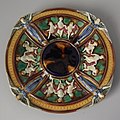 Coloured glazes majolica Angels dessert plate, c. 1867, Revivalist in style
Coloured glazes majolica Angels dessert plate, c. 1867, Revivalist in style -
 Coloured glazes majolica centrepiece, 16.3 in, c. 1889, Revivalist and naturalistic in style
Coloured glazes majolica centrepiece, 16.3 in, c. 1889, Revivalist and naturalistic in style -
 Coloured glazes majolica primroses cheese keep, c. 1876, naturalistic in style
Coloured glazes majolica primroses cheese keep, c. 1876, naturalistic in style -
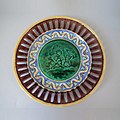 Coloured glazes majolica, intaglio pictorial centre 'Email Ombrant', c. 1871, Classical style
Coloured glazes majolica, intaglio pictorial centre 'Email Ombrant', c. 1871, Classical style -
 Mottled coloured glazes Victorian majolica, c. 1865, border in Greek key style
Mottled coloured glazes Victorian majolica, c. 1865, border in Greek key style -
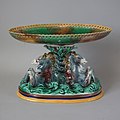 Coloured glazes majolica hippocamp centrepiece, c. 1869, Classical mythology in style
Coloured glazes majolica hippocamp centrepiece, c. 1869, Classical mythology in style -
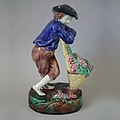 Coloured glazes majolica figural vintager, c. 1875, naturalistic in style
Coloured glazes majolica figural vintager, c. 1875, naturalistic in style
George Jones
The Trent Pottery, George Jones and Sons,[28] made majolica cupids, shells, dolphins, birds, figurines and coral designs in numerous shapes including highbrow centrepieces alongside snuff boxes, spittoons, dog bowls, vases, serving dishes, tea sets, jugs, cheese keeps, desk sets, garden seats and pie dishes. Their mark was a monogram of the initials "G.J." joined together. A beehive bread dish with a cover has a design of wild roses against a background of basketwork and has the Trent Pottery mark. Flowerpots were made in bright colours and with raised designs of natural flowers.
-
 Squirrel nut dish, 1869, naturalistic style
Squirrel nut dish, 1869, naturalistic style -
 'Neptune', coloured glazes, 1870, Revivalist influence
'Neptune', coloured glazes, 1870, Revivalist influence -
 Spitoon, coloured glazes majolica, c. 1880
Spitoon, coloured glazes majolica, c. 1880 -
 Snuff box, coloured glazes majolica with pewter lid, c. 1870, naturalistic goat figure
Snuff box, coloured glazes majolica with pewter lid, c. 1870, naturalistic goat figure -
 Amphora vase, c. 1870, Egyptian style
Amphora vase, c. 1870, Egyptian style -
 Flower pot, coloured lead glazes on biscuit, raised design of natural flowers
Flower pot, coloured lead glazes on biscuit, raised design of natural flowers -
 Bird jug, c. 1870, naturalistic style.
Bird jug, c. 1870, naturalistic style. -
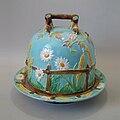 Cheese keep and stand, c. 1870, naturalistic style
Cheese keep and stand, c. 1870, naturalistic style -
 Ladies' desk set for inks, sand and quills, c. 1871, naturalistic style
Ladies' desk set for inks, sand and quills, c. 1871, naturalistic style -
 Lily dish with kingfisher, c. 1873, naturalistic style
Lily dish with kingfisher, c. 1873, naturalistic style -
 Trinket dish, coloured glazes, c. 1874, spectacularly Naturalistic in style
Trinket dish, coloured glazes, c. 1874, spectacularly Naturalistic in style -
 Tea set, c. 1873, naturalistic apple blossom pattern
Tea set, c. 1873, naturalistic apple blossom pattern -
 Garden seat, c. 1875, naturalistic style
Garden seat, c. 1875, naturalistic style -
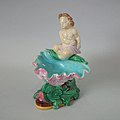 Merman and dolphin dish, c. 1875, Revivalist style
Merman and dolphin dish, c. 1875, Revivalist style -
 Sardine dish, coloured glazes, c. 1875, spectacularly naturalistic
Sardine dish, coloured glazes, c. 1875, spectacularly naturalistic -
 Pie dish, coloured glazes, c. 1877, spectacularly naturalistic in style
Pie dish, coloured glazes, c. 1877, spectacularly naturalistic in style -
 Frog and insect vase, c. 1880, naturalistic in style
Frog and insect vase, c. 1880, naturalistic in style
Joseph Holdcroft
-
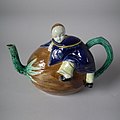 Coloured glazes Oriental Boy on Coconut Teapot and cover, c. 1870
Coloured glazes Oriental Boy on Coconut Teapot and cover, c. 1870 -
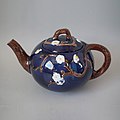 Coloured glazes Floral Teapot and cover, c. 1880
Coloured glazes Floral Teapot and cover, c. 1880 -
 Coloured glazes cheese keep, naturalistic style.
Coloured glazes cheese keep, naturalistic style. -
 Coloured glazes garden seat, naturalistic style.
Coloured glazes garden seat, naturalistic style. -
 Coloured glazes fish and lilies jardiniere, naturalistic style
Coloured glazes fish and lilies jardiniere, naturalistic style -
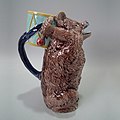 Holdcroft jug, 9.6 in, c. 1870, naturalistic coloured glazes majolica
Holdcroft jug, 9.6 in, c. 1870, naturalistic coloured glazes majolica -
 Holdcroft Asparagus server table ware, 13.4 in, c. 1870, naturalistic coloured glazes majolica
Holdcroft Asparagus server table ware, 13.4 in, c. 1870, naturalistic coloured glazes majolica -
 Holdcroft Dessert plate, coloured glazes, c 1870, naturalistic style
Holdcroft Dessert plate, coloured glazes, c 1870, naturalistic style -
 Wall Pocket coloured glazes, c. 1870, naturalistic in style
Wall Pocket coloured glazes, c. 1870, naturalistic in style -
 Cheese Dome and Stand, coloured glazes, naturalistic in style, c. 1880
Cheese Dome and Stand, coloured glazes, naturalistic in style, c. 1880 -
 Coloured glazes box and cover, Aesthetic style, c. 1880
Coloured glazes box and cover, Aesthetic style, c. 1880 -
 Coloured glazes swan vase, c. 1875, naturalistic in style
Coloured glazes swan vase, c. 1875, naturalistic in style -
 Coloured glazes swan base, impressed pattern number
Coloured glazes swan base, impressed pattern number -
 Coloured glazes frog toothpick holder, c. 1870
Coloured glazes frog toothpick holder, c. 1870
Brownfield
-
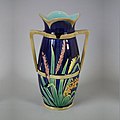 Coloured glazes vase, c. 1875
Coloured glazes vase, c. 1875 -
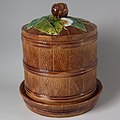 Chestnut finial coloured glazes dish and cover, c. 1880
Chestnut finial coloured glazes dish and cover, c. 1880 -
 Cats Vase, coloured glazes, c. 1875
Cats Vase, coloured glazes, c. 1875 -
 Cheese keep and underplate, coloured glazes, c. 1870
Cheese keep and underplate, coloured glazes, c. 1870 -
 Coloured glazes majolica Cockatoo, c. 1870
Coloured glazes majolica Cockatoo, c. 1870 -
 Brownfield coloured glazes majolica Sauceboat, c. 1870, Revivalist references
Brownfield coloured glazes majolica Sauceboat, c. 1870, Revivalist references -
 Brownfield Peasant Figures, 13.2 in, coloured glazes majolica, c. 1880
Brownfield Peasant Figures, 13.2 in, coloured glazes majolica, c. 1880
Brown Westhead Moore
- Brown-Westhead, Moore & Co[30]
-
 Garden Seat, coloured lead glazes
Garden Seat, coloured lead glazes -
 Butterfly box and cover, coloured glazes, c. 1860
Butterfly box and cover, coloured glazes, c. 1860 -
 Rabbit box and cover, coloured glazes, c. 1870
Rabbit box and cover, coloured glazes, c. 1870 -
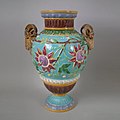 Vase, coloured glazes, c. 1875
Vase, coloured glazes, c. 1875 -
 Brown Westhead Moore coloured glazes hexagonal teapot and cover, c. 1870
Brown Westhead Moore coloured glazes hexagonal teapot and cover, c. 1870
Copeland
- Copeland[31] & Garrett, successors to Josiah Spode
-
 Copeland coloured glazes majolica, 'Sloth and Mischief'
Copeland coloured glazes majolica, 'Sloth and Mischief' -
 Cauliflower teapot, coloured glazes, naturalistic in style, c. 1870
Cauliflower teapot, coloured glazes, naturalistic in style, c. 1870 -
 Centrepiece, 16.5 in, coloured glazes, Revivalist in style, c. 1870
Centrepiece, 16.5 in, coloured glazes, Revivalist in style, c. 1870 -
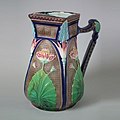 Jug-Pitcher, 7.8 in, coloured glazes, Revivalist in style, c. 1877
Jug-Pitcher, 7.8 in, coloured glazes, Revivalist in style, c. 1877 -
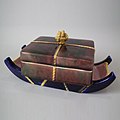 Sardine box, 9.3 in, coloured and mottled glazes, quirky 'High Victorian' in style, c. 1870
Sardine box, 9.3 in, coloured and mottled glazes, quirky 'High Victorian' in style, c. 1870 -
 Spoon warmer, 9.3 in, coloured and mottled glazes, quirky naturalistic in style, c. 1870
Spoon warmer, 9.3 in, coloured and mottled glazes, quirky naturalistic in style, c. 1870
Thomas Forester
- Thomas Forester & Sons[32]
-
 Garden seat, 20.9 in, coloured glazes, c. 1880, storks and bamboo pattern
Garden seat, 20.9 in, coloured glazes, c. 1880, storks and bamboo pattern -
 Tea set, coloured glazes, c. 1880, hazelnut pattern
Tea set, coloured glazes, c. 1880, hazelnut pattern
Samuel Lear
- Samuel Lear[33]
-
 Lear Dessert plate, coloured glazes majolica, c. 1880, sunflowers pattern
Lear Dessert plate, coloured glazes majolica, c. 1880, sunflowers pattern -
 Lear Jug, coloured glazes majolica, c. 1880, lily of the valley pattern
Lear Jug, coloured glazes majolica, c. 1880, lily of the valley pattern -
 Oyster plate, 9.6 in, coloured glazes, c. 1881, sunflower pattern
Oyster plate, 9.6 in, coloured glazes, c. 1881, sunflower pattern
- Poole and Unwin
Fielding
- S. Fielding and Co., The Railway Pottery, Stoke on Trent[34]
- Daniel Sutherland and Sons
- James Woodward
Adams and Bromley
- J.W. John Adams and Co., Hanley[35]
-
 Ewers, coloured glazes, c. 1880, Renaissance in style
Ewers, coloured glazes, c. 1880, Renaissance in style
- Edge, Malkin & Co, Burslem
Royal Worcester
-
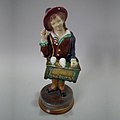 Coloured glazes majolica organ grinder figure, 9.3 in, c. 1870
Coloured glazes majolica organ grinder figure, 9.3 in, c. 1870 -
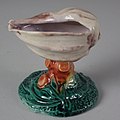 Salt, coloured glazes, moulded in relief, c. 1880, naturalistic shell
Salt, coloured glazes, moulded in relief, c. 1880, naturalistic shell -
 Candlesticks, coloured glazes, moulded in relief, c. 1880, naturalistic in style with historical references
Candlesticks, coloured glazes, moulded in relief, c. 1880, naturalistic in style with historical references
Doulton Lambeth
-
 Doulton Lambeth Conservatory table, 18.5 in, coloured glazes majolica, c. 1870, Indian subcontinent in style, a reminder of Empire
Doulton Lambeth Conservatory table, 18.5 in, coloured glazes majolica, c. 1870, Indian subcontinent in style, a reminder of Empire
Victoria Pottery Company
- Victoria Pottery[36]
-
 VPC Victoria Pottery Company Sardine Box and cover, 7.9 in, coloured glazes majolica, c. 1880
VPC Victoria Pottery Company Sardine Box and cover, 7.9 in, coloured glazes majolica, c. 1880 -
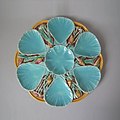 VPC Victoria Pottery Company Oyster plate, 10 in, coloured glazes majolica, c. 1880
VPC Victoria Pottery Company Oyster plate, 10 in, coloured glazes majolica, c. 1880 -
 Victoria Pottery Company Pie dish and cover, coloured glazes, c. 1880
Victoria Pottery Company Pie dish and cover, coloured glazes, c. 1880
John Roth
- J. Roth[37]
-
 J.R.L. John Roth of London Pot and cover, coloured glazes majolica, c. 1880, begonia leaf design
J.R.L. John Roth of London Pot and cover, coloured glazes majolica, c. 1880, begonia leaf design
European and American makers
Majolica from other countries is included in this article for two reasons:
- The term Victorian is occasionally used also to describe majolica made in other countries.
- European and American makers employed English immigrant technicians and copied Minton's Victorian coloured glazes majolica process and styles.
France
APT
-
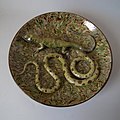 Wall plate, c. 1900, coloured and mottled glazes in Palissy style
Wall plate, c. 1900, coloured and mottled glazes in Palissy style
Barbizet
-
 Palissy wall plate, coloured lead glazes on biscuit, c. 1870
Palissy wall plate, coloured lead glazes on biscuit, c. 1870
Brard
-
 Palissy majolica c. 1880. Platter is opaque white tin-glazed with cobalt oxide brush-painted decoration, and the applied fish are of coloured glazes majolica.
Palissy majolica c. 1880. Platter is opaque white tin-glazed with cobalt oxide brush-painted decoration, and the applied fish are of coloured glazes majolica.
Delphin Massier
-
 'Birds and Well', 13.6 in, coloured glazes majolique, c. 1880
'Birds and Well', 13.6 in, coloured glazes majolique, c. 1880 -
 Posy Vase, 14.6 in, coloured glazes, c. 1900
Posy Vase, 14.6 in, coloured glazes, c. 1900 -
 Coloured glazes majolica basket, c. 1900
Coloured glazes majolica basket, c. 1900
Perret-Gentil
-
 Perret Gentil Menton coloured lead glazes majolica plate
Perret Gentil Menton coloured lead glazes majolica plate -
 Wall Plate, 9.6 in, coloured glazes, Palissy style, Menton, France
Wall Plate, 9.6 in, coloured glazes, Palissy style, Menton, France
Sarreguemines
La majolique[38]
- "A la fin des années 1870 apparaît un produit qui renforce la notoriété de Sarreguemines en Europe:la majolique. Il s'agit d'une faïence fine recouverte de glaçures colorées. Les couleurs privilégiées: le gros bleu, le bleu turquoise, le vert dit bronze. Les bibelots, « objets de fantaisie » ainsi que certaines pièces monumentales bénéficient largement de cette nouvelle technique."
-
 Coloured glazes Sarreguemines majolica partridges plaque
Coloured glazes Sarreguemines majolica partridges plaque -
 Sarreguemines Majolica Eagles bowl, 16 in
Sarreguemines Majolica Eagles bowl, 16 in -
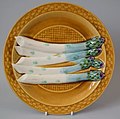 Asparagus plate, c. 1880
Asparagus plate, c. 1880 -
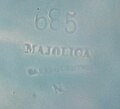 Sarreguemines Majolica makers mark
Sarreguemines Majolica makers mark -
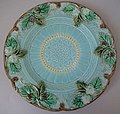 Sarreguemines Majolica Majolique Strawberry plate, c. 1880
Sarreguemines Majolica Majolique Strawberry plate, c. 1880 -
 Sarreguemines Majolica Majolique 'Mardis Gras' Wall Pockets, c. 1890
Sarreguemines Majolica Majolique 'Mardis Gras' Wall Pockets, c. 1890
Thomas Sergent
-
 Thomas Sergent Platter, c. 1875, coloured glazes, ultra-naturalistic Palissy style
Thomas Sergent Platter, c. 1875, coloured glazes, ultra-naturalistic Palissy style -
 Oyster plates, c. 1880, coloured glazes, Palissy style
Oyster plates, c. 1880, coloured glazes, Palissy style
Choisy le Roi
-
 Cockerel (Rooster), 14.6 in, coloured glazes, c. 1880
Cockerel (Rooster), 14.6 in, coloured glazes, c. 1880
Boch Freres
-
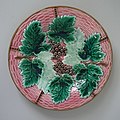 Boch Freres Kermis Plate, coloured glazes, c. 1880, grapes and vine leaves pattern
Boch Freres Kermis Plate, coloured glazes, c. 1880, grapes and vine leaves pattern
Longchamp
-
 Coloured glazes majolica lobster platter 18.9 in, c. 1880.
Coloured glazes majolica lobster platter 18.9 in, c. 1880. -
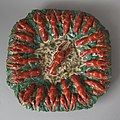 Coloured glazes majolica lobsters dish wall plaque, c. 1880
Coloured glazes majolica lobsters dish wall plaque, c. 1880
Luneville
-
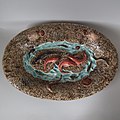 22.4 in coloured glazes majolica marine platter, c. 1880.
22.4 in coloured glazes majolica marine platter, c. 1880.
Orchies
Nimy
Onnaing
Salins
Vallauris
Portugal
Augusta Baptista de Carvalho
-
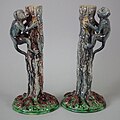 Candlesticks, 9.4 in, coloured glazes, Palissy style
Candlesticks, 9.4 in, coloured glazes, Palissy style
Avelena Soares
-
 Wall plate, 10.4 in, coloured glazes, ultra-naturalistic Palissy style
Wall plate, 10.4 in, coloured glazes, ultra-naturalistic Palissy style
Bordalo Pinheiro
-
 Wall pocket, coloured glazes, c. 1888, shellfish and seaweed Palissy majolica
Wall pocket, coloured glazes, c. 1888, shellfish and seaweed Palissy majolica
Cunha
-
 Wall plate, 11 in, coloured glazes, Palissy style
Wall plate, 11 in, coloured glazes, Palissy style
José Francisco de Sousa
-
 Wall plate, 10.4 in, coloured glazes, Palissy style
Wall plate, 10.4 in, coloured glazes, Palissy style -
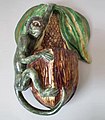 Coloured glazes palissy majolica wall pocket, c. 1890
Coloured glazes palissy majolica wall pocket, c. 1890
Manuel Cipriano Gomes Mafra
-
 Coloured glazes palissy majolica toads and pond life wall plate, c. 1890
Coloured glazes palissy majolica toads and pond life wall plate, c. 1890 -
 Coloured glazes palissy majolica beetle wall ornament, 3.1 in, c. 1890
Coloured glazes palissy majolica beetle wall ornament, 3.1 in, c. 1890 -
 Ewer, cover, and stand, 13.6 in, c. 1870, ultra-naturalistic Palissy majolica
Ewer, cover, and stand, 13.6 in, c. 1870, ultra-naturalistic Palissy majolica -
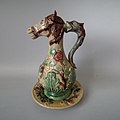 Horse Ewer, 14.6 in, coloured glazes, Palissy style
Horse Ewer, 14.6 in, coloured glazes, Palissy style -
 Wall plate, 15.2 in, coloured glazes, Palissy style
Wall plate, 15.2 in, coloured glazes, Palissy style
Germany
Krause (Germany, now in Poland) Reichard Krause, quality German maker late 19th century, coloured majolica glazes, styles classical and naturalistic, usually with clear K/M shield makers marks.
-
 Coloured glazes majolica jardinière and vases, c. 1890
Coloured glazes majolica jardinière and vases, c. 1890
Eichwald
-
 Trinket box, 9.4 in, coloured glazes majolica, c. 1890
Trinket box, 9.4 in, coloured glazes majolica, c. 1890
Bloch, Villeroy & Boch (Luxemburg)
W S Schiller
-
 Spill Vase, coloured glazes, c. 1890
Spill Vase, coloured glazes, c. 1890
Austria
Hugo Lonitz
-
 Lonitz, 1880, naturalistic, molded in relief, coloured glazes.
Lonitz, 1880, naturalistic, molded in relief, coloured glazes. -
 Lonitz Swan figure, coloured glazes majolica, c. 1870
Lonitz Swan figure, coloured glazes majolica, c. 1870 -
 Cache pots and stands, coloured glazes, c. 1880
Cache pots and stands, coloured glazes, c. 1880
Sweden
Gustafsberg
-
 Gustafsberg Jardiniere Stand, coloured glazes, c. 1878, naturalistic with mythological theme, Sweden
Gustafsberg Jardiniere Stand, coloured glazes, c. 1878, naturalistic with mythological theme, Sweden -
 Gustafsberg Dessert service platter, coloured glazes, c. 1880, naturalistic theme, Sweden
Gustafsberg Dessert service platter, coloured glazes, c. 1880, naturalistic theme, Sweden -
 Coloured lead glazes majolica Gustafsberg vase, c. 1880
Coloured lead glazes majolica Gustafsberg vase, c. 1880 -
 Bird Vases, 1887, Sweden. Coloured glazes, naturalistic in style.
Bird Vases, 1887, Sweden. Coloured glazes, naturalistic in style. -
 Nautilus shell Vase, 1899, Sweden. Coloured glazes, naturalistic in style.
Nautilus shell Vase, 1899, Sweden. Coloured glazes, naturalistic in style.
-
 Vases, c. 1880. Coloured glazes, naturalistic in style.
Vases, c. 1880. Coloured glazes, naturalistic in style.
America
Several American firms also made majolica, with the English born Edwin Bennett producing it in Baltimore as early as the 1850s.[39] The best known are Griffin, Smith and Hill of Phoenixville, Pennsylvania, whose Etruscan majolica made from 1880 to 1890 includes compotes with dolphin supports and flower, shell, or jewel cups, a design of coral weed and seashells, and tableware with leaves and ferns. Their mark was an impressed monogram, "G.S.H.", sometimes circled and with the words "Etruscan Majolica".
Majolica was also made by Odell and Booth at Tarrytown, New York, and by the Faience Manufacturing Company at Greenpoint, Long Island, whose mark is an incised "F.M. Co." Their pottery was dipped in coloured glazes, creating a streaked or marbled effect. Majolica was made at Evansville, Indiana. Work from the Chesapeake Pottery in Baltimore was called Clifton Ware and was marked "Clifton Decor 'R'" with the monogram "D.F.H.".
The Arsenal Pottery of Trenton, New Jersey, was making majolica as late as 1900 and exhibited Toby jugs in imitation of English Toby jugs at the World's Columbian Exposition, Chicago (1893).
-
 Eureka Pottery coloured glazes majolica, Trenton, New Jersey
Eureka Pottery coloured glazes majolica, Trenton, New Jersey
See also

Notes
- ^ 1877, Leon Arnoux, Pottery, British Manufacturing Industries, http://www.gutenberg.org/files/38953/38953-h/38953-h.htm, Gutenberg pages 392-394, The name of majolica is now applied indiscriminately to all fancy articles of coloured pottery. When, however, it is decorated by means of coloured glazes [coloured lead glazes], if these are transparent [translucent], it ought to be called Palissy ware [coloured glazes], from the name of the great artist who used these for his beautiful works.
- ^ blue (cobalt oxide), green (copper oxide), brown (manganese dioxide), yellow (iron oxide), etc.
- ^ 2018, Claire Blakey, Minton Majolica: A Visual Feast of Victorian Opulence Minton Archive http://www.themintonarchive.org.uk/in-depth-minton-majolica/[permanent dead link] "Majolica is the term used to describe pottery made of an earthenware body coated with semi-translucent coloured lead glazes. It was developed at the Minton factory in the late 1840s by Léon Arnoux, who had come to the Potteries in 1848."
- ^ See wikt:majolica for quotations, citations
- ^ Unambiguous citations for the two distinct 'majolicas' (distinct in appearance, origin, history, style, and manufacturing process/technique) will contain the word 'majolica' along with a qualifier to show which product is being cited.
- Majolica meaning tin-glazed earthenware: Qualifiers – dateable to before 1848, 'maiolica', 'tin-glazed', 'tin-enameled', 'opaque', 'white', 'brushwork', 'delft', 'stanniferous', 'faience', 'Minton tin-glazed majolica'.
- Majolica meaning colored lead glazes earthenware: Qualifiers – dateable to after 1848, used in the same sentence as tin-glaze majolica/maiolica, 'coloured glazes', 'Mintons Palissy ware', 'lead-glazed majolica'
- ^ Leon Arnoux, 1867, British Manufacturing Industry - Report on Pottery, p.42 [1]"Majolica [tin-glaze earthenware, opaque white surface brush-painted in enamel colours] was produced for the first time by Messrs. Minton, in 1850, and they have been for many years the only producers of this article. The name of majolica is now applied indiscriminately to all fancy articles of coloured pottery. When, however, it is decorated by means of coloured glazes [applied directly to the 'biscuit'], if these are transparent [translucent], it ought to be called Palissy ware ... Messrs. Wedgwood, George Jones, and a few other makers of less importance, are reproducing it more or less successfully. To Messrs. Minton, however, we owe the revival of the ware [the coloured lead glazes ware that they named 'Palissy ware'], which, in connection with [in addition to] their majolica [the tin-glaze product], created such a sensation in the French International Exhibition of 1855."
- ^ monumental exhibition pieces, ornamental vases, flower pots, household table services, decorative candlesticks, centrepieces, desk and dressing table paraphernalia, floor and fire-surround tiles, garden seats, walking stick holders, dog bowls, etc.
- ^ Editorial Staff, Art Journal Catalogue (1862). "Exhibited Class XXXV, no.6873, D78".
The Italian Vase [top, left, p.8] is Majolica [tin-glazed imitation Italian maiolica], [...] The Ewer [bottom, middle, p.8] is a Palissy vase [coloured glazes].
- ^ Inspired by historical wares
- ^ Derived from or closely imitating real life or nature
- ^ Arnoux, Leon (1877). "Pottery, British Manufacturing Industries". Gutenberg. pp. 392–394.
[...]majolica [tin-glazed], Palissy [coloured lead glazes], Persian ware, and flooring and wall tiles. I have given the name of majolica [tin-glazed] to that class of ornament whose surface is covered with opaque enamels[...]the opacity[...]is produced by the oxide of tin; [...]. Majolica [tin-glazed] was produced for the first time by Messrs. Minton, in 1850, and they have been for many years the only producers of this article. [...]majolica [tin-glazed], created such a sensation in the French International Exhibition of 1855
- ^ Digby Wyatt, M., Journal of the Society of Arts, May 26, 1858, p.448
- ^ Brush-applied decoration becomes 'embedded' upon contact with the 'raw' unfired tin-glaze, somewhat in the manner of fresco, with no possibility of alteration or overpainting.
- ^ "Magnificent Majolica: Kirkby's Mantegna – the Minton Archive".
- ^ Butler, Charles (1633). "English Grammar". London.
The first English language book to make a clear distinction between i and j was published in 1633.
- ^ * Merriam-Webster Online [2]
- Oxford Dictionaries online [3]
- ^ Art Journal, 1850, Catalogue to Mediaeval Exhibition "...sections are thus enumerated in the catalogue:- ... 4. Italian Majolica [tin-glazed Italian maiolica]; ... 7. Palissy Ware [16th century]; ..."
- ^ Christie, Manson & Woods Catalogue, June 16, 1884, Sale of Fontaine Collection of Majolica [tin-glazed Italian], Henri II, Palissy Ware [16th century] ...
- ^ Paul Atterbury and Maureen Batkin, 1997, 'Dictionary of Minton', Antique Collectors' Club. "Minton did not use the word maiolica themselves, relying instead on the Victorian version, majolica, which they used to mean wares of Renaissance inspiration, featuring hand painting on an opaque white glaze. These were therefore quite distinct from the coloured glaze decorated wares also called majolica, but which Minton referred to as Palissy wares."
- ^ "Magnificent Majolica: The First – the Minton Archive".
- ^ Light and dark created by glaze pooling in the lower areas of a relief moulding.
- ^ Catalogue, (1851), Official Descriptive and Illustrated Catalogue in Three Volumes, Volume II. London. W. Clowes & Sons
- ^ Digby Wyatt, M., Journal of the Society of Arts May 26 (1858) p.442
- ^ in-glaze decoration
- ^ The Illustrated London News, Nov. 10, 1855, p. 561
- ^ M is for Maiolica/majolica, Victoria and Albert Museum
- ^ http://majolicasociety.com/wedgwood/
- ^ http://majolicasociety.com/george-jones/
- ^ http://majolicasociety.com/joseph-holdcroft/
- ^ http://majolicasociety.com/t-c-brown-westhead-moore/
- ^ http://majolicasociety.com/copeland/
- ^ http://majolicasociety.com/thomas-forester/
- ^ http://majolicasociety.com/samuel-lear/
- ^ http://majolicasociety.com/simon-fielding/
- ^ http://majolicasociety.com/adams-bromley/
- ^ http://majolicasociety.com/victoria-pottery/
- ^ http://majolicasociety.com/j-roth/
- ^ "Musée de la Faïence".
- ^ Schneider 1999, p. 19
References
- Arnoux, Leon, British Manufacturing Industries, Gutenberg, 1877. [4]
- Karmason, Marylin J., and Stacke, Joan B., Majolica: A Complete History and Illustrated Survey, 1989, Harry N. Abrams, Inc.
- Atterbury, Paul, and Batkin, Margaret, Dictionary of Minton, Antique Collectors' Club, 1990.
- Katz Marks, Mariann, "The Collector's Encyclopedia of Majolica", Collector Books
- Schneider, M. Majolica. Pennsylvania: Schiffer Publishing, Ltd. 1999.
External links

- "In Depth: Minton Majolica"[permanent dead link], Mintons archive, with large range of designs online
- Old and Sold
- The Majolica Society
- The Minton Archive
- Potteries Museum and Art Gallery, Stoke-on-Trent, UK















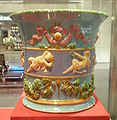







![Minton tin-glazed Majolica oval plate, painting by Kirkby,[14] after Triumphs of Caesar (Mantegna). Almost identical example in V&A.](http://upload.wikimedia.org/wikipedia/commons/thumb/8/8e/Minton_tin-glaze_Majolica_oval_plate_decorated_by_Thomas_Kirkby_in_Renaissance_style_after_Mantegna_original.jpg/98px-Minton_tin-glaze_Majolica_oval_plate_decorated_by_Thomas_Kirkby_in_Renaissance_style_after_Mantegna_original.jpg)


























































































































































